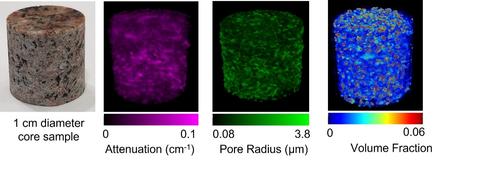INFER
Far-field Interferometry for Measurement of Heterogeneous and Hierarchical Structures
Heterogeneity is the Achilles heel of neutron scattering owing to the bulk average nature of the structural characterization method. Heterogeneity is generally avoided in experiment design to enable data analysis and interpretation and to this end many neutron scattering experiments are performed on model systems. Alternatively, simple analysis methods are used to extract more limited structural information from heterogeneous systems. Despite these limitations, small-angle neutron scattering (SANS) is one of the best methods for measuring nanoscale information in soft materials and magnetic systems. Neutron imaging is one approach for looking at larger scale structures with neutrons, but the resolution is limited to the microns and larger scale. Neutron imaging has been used to measure distribution of water in operating fuels cells and roots growing in soils with and without water retention additives, but it can’t tell you anything about the nanoscale structure within the sample.
The NIST Innovations in Measurement Science Program supported “INFER” project supports the development of a grating based far-field interferometry instrument which will enable measurements that combine the best of the SANS and Neutron Imaging. The new instrument will produce tomograms (3-dimensional images) with voxels as small as 25 µm that each contain neutron attenuation and SANS equivalent real space correlograms with information about structure on length scales of 1 nm – 10 µm. The new instrument will lead to unprecedented insights on local nanostructure in operating batteries and fuel cells, degradation of concrete due to weather and aging, local structure within different mineral and organic regions of geological samples, and degradation, dissolution, or structural changes in pharmaceutical delivery devices, tissue scaffolds or blood clots (to name a few) in biologically relevant environments.


Progress During the Unplanned Outage
Source and Phase Grating Progress
- Improved phase grating fabrication methods
- Reduce edge scalloping and other etch artifacts
- Develop Nickel infill capabilities to enhance grating visibility
- Dynamic Source Grating
- Prototype microfluidic dynamic attenuation grating with 128 channels fabricated, exceeding our 2-year go / no-go milestone
- Neutron blocking gadolinium salt solution (GadInk) developed and beta tested
- GadInk delivery via wicking and pressure driven nozzle system developed and tested
- Reduction to practice demonstrated on x-ray imaging instrument
- Provisional patent filed
- Final design of fully functional 5000 channel two-sided dynamic grating device is underway, and we expect to meet our final target!
- Initial test of anodic bonding completed for final sealed device
Simulation and Data Analysis
- Developed a tool to leverage SASModels package (from SASview) to generate simulated correlograms for infer data
- First step to enabling fitting of multiple form factors for infer data
- Enables predictions of sample feasibility prior to measurement
- Provides “correlograms” for use in the interferometer simulation
- Developed a tool to simulate raw far field interferometer data
- Will enable progress on data reduction and processing in the absence of neutron data
- Critical to efforts to enable machine learning algorithms for image segmentation and model fitting of correlograms.
Travelling Experiment Campaigns
- Los Alamos National Labs (Asterix), December 2021
- Traveling set of attenuation gratings with a limited set of periods fabricated for traveling interferometry campaigns
- Phase gratings and attenuation gratings characterized as a function of wavelength.
- Demonstrated visibility >30% for broad range of autocorrelation lengths, meeting our final target for this metric
- Oak Ridge National Lab (CG-1D), Feb-March 2022
- Phase gratings fabricated optimized for CG-1D beamline spectrum
- A series of simple samples for instrument validation and material science case studies performed with interferometer optimized to capture a length scale from 10-400 nm
- Polystyrene spheres (varied size, concentration, contrast)
- Pluronic solutions
- Amorphous solid dispersions (pharmaceutical applications)
- Additively manufactured dog bones (various materials and strains)
- Cement for carbon sequestration
- Geological samples
- And more…
For more information on the project and team: https://www.nist.gov/programs-projects/interferometry-infer-neutron-interferometric-microscopy-small-forces-and

